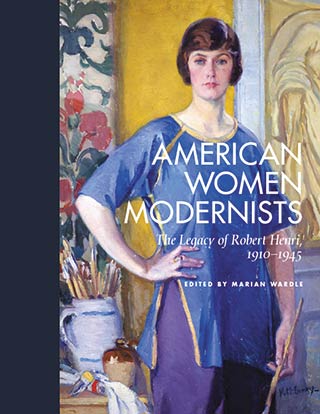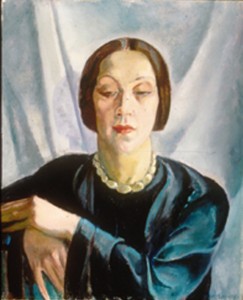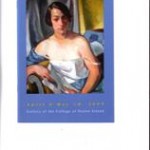Art Inconnu
ArtVoice
The Rediscovery of Kathleen McEnery
by Dean Brownrout
Kathleen McEnery's self-portrait on the cover of a book about Robert Henri, one of her mentors.
In the early 1910s, artist Kathleen McEnery was a rising presence in the New York City art community. She exhibited alongside contemporaries George Bellows, Stuart Davis, and Edward Hopper. By the time of her death in 1971, in Rochester, New York, she was almost completely forgotten as an artist outside of the region.
The Massachusetts-raised McEnery, born in 1885, was passionate about becoming an artist. She moved to New York City to study, most notably, with Ashcan School painter Robert Henri. In 1908, she traveled with Henri’s class to Madrid, and stayed on in Paris. It was the start of a promising time.
McEnery returned to New York City in 1910 and began to exhibit widely.
Her work was influenced by the realist style of Henri, but also showed modernist tendencies informed by her time abroad.
In 1913, she exhibited two paintings at the groundbreaking Armory Show in New York City. The exhibition presented over 1,000 contemporary European and American artworks—and changed the face of modern art forever. McEnery’s future as an artist seemed assured.
How did her fortunes change? While her rediscovery does appear to be happening years after her passing, her story isn’t one of a tortured artist toiling in obscurity and dying in poverty.
McEnery married automobile manufacturer Francis Cunningham and moved to Rochester, where her husband’s business was based. Like many young, affluent women, McEnery devoted herself to family and community. She painted portraits of friends. The last metropolitan exhibit during her lifetime was at the Ferargil Gallery in New York City, in 1926.
In 1995, art historian Janet Wolff discovered McEnery’s work. She spearheaded a passionate campaign of articles and exhibitions featuring it.
Douglas Howard, vice president of academic affairs at Medaille College in Buffalo, contributed a catalog essay to Wolff’s 2003 McEnery retrospective at the Hartnett Gallery in Rochester.
He says, “It’s powerful and interesting work. McEnery retreated to marriage and the provinces.” Howard cites “her geographic remove from the epicenters of modernism” as an overarching reason she did not share in the ascendancy of her contemporaries.
One of her Armory Show paintings is now in the collection of the National Museum of American Art. In 2005, a McEnery self-portrait was featured on the cover of American Woman Modernists: The Legacy of Robert Henri (Rutgers University Press). With such attention finally being paid to her work, her place in our regional art history is assured, and her position in the art world is on the rise again.
Dean Brownrout is president of 20th Century Finest (www.20thcenturyfinest.com), dedicated to researching and trading in artwork by historically important, regional artists of the 20th century.
VCS20TH
- Kathleen McEnery: Mood 1927

Kathleen McEnery: Mood, 1927
(Memorial Art Gallery, Rochester)
By Janet Wolff
This is as good an image to talk about as any. It’s the first work I came across by the American artist Kathleen McEnery (1888-1971). I included it in a small exhibition I curated at the Memorial Art Gallery, Rochester, in 1995, of images of women, as part of a larger project celebrating the 75th anniversary of women’s suffrage in the U.S. After that I became interested in her work and life. Through contact with her family (her son Peter – the only one of her three children still alive at the time, though he died in 2003 – and twelve of her many grandchildren) I was able to see more than a hundred and twenty of her paintings. With the invaluable help of Lucy Curzon, then a graduate student in VCS, I curated an exhibition of her work at the Hartnett Gallery in 2003, and later helped Nanette Salomon curate another McEnery exhibition at the Gallery of the College of Staten Island, in April 2005. And later that year McEnery was included in a major exhibition of the “new women” art students of Robert Henri at Brigham Young University Museum of Art; her self-portrait featured on the cover of the catalogue.



Woman in an Ermine Collar
Fritz Trautmann
Colette
And there’s a lovely portrait of her friend (another Rochester grande dame) Charlotte Whitney Allen at R.I.T.: Woman seated
(and two other portraits of Allen on display, in the Eastman Theatre and in the MAG library).
Finding McEnery meant that I spent much of my last year in Rochester (2000-2001) learning a good deal about George Eastman’s city – a great cultural centre in the 1920s and 1930s. I wrote an essay about McEnery in my book AngloModern (2003), with a still life of hers on the cover. Now I’m writing something in a more personal vein about the people I learned about during that period of research, some of whom I interviewed when they were in their 90s.
Janet Wolff: I was Director of VCS from 1991 to 2001. Before that, I taught at the University of Leeds (UK) for fifteen years. In 2001 I went to Columbia University, where I was Associate Dean for Academic Affairs in the School of the Arts. In 2006 I moved back to England, and am now Director of the Centre for Interdisciplinary Research in the Arts at the University of Manchester (so I’m also back in my home town). My two most recent books are AngloModern: Painting and Modernity in Britain and the United States (2003) and The Aesthetics of Uncertainty (2008). Now I’m writing a book which is a combination of memoir, family history, and cultural history, with photos, facsimile documents, paintings and other images.
https://blogs.rochester.edu/vcs20th/?p=6
Mining in the Field of Art
http://zerne.wordpress.com/2008/09/20/
American Studies at the University of Virginia
"The Part Played By Women:"
The Gender of Modernism at the Armory Show
http://xroads.virginia.edu/~museum/armory/gender.html
http://xroads.virginia.edu/~museum/armory/galleryD/tour.d2.html
http://xroads.virginia.edu/~museum/armory/galleryD/mcenery.4.html
http://xroads.virginia.edu/~Museum/Armory/galleryD/mcenery.3.html
Staten Island Advance
What she did for love
CSI gallery shows works by the best painter you've never heard of, Kathleen McEnery
Staten Island Advance - May 1, 2005
Famous painters -- Cezanne, Cassatt, Renoir, even Matisse -- are hovering over the current exhibition at the College of Staten Island Gallery, a showcase devoted to a virtual unknown. She is Kathleen McEnery (1888-1971) and she is the best painter you've never heard of. How come? Her life got in the way of her art. Instead of a possibly international career, she chose a husband, children and a home in upstate Rochester. It's the old story: Gifted woman (who is liable to be ignored by patriarchal powers in any event) trades brilliance for Brillo and babies. Naturally, however, there are unique circumstances. Born in Brooklyn, Ms. McEnery was already traveling to Manhattan to study with well-known realist painter Robert Henri as a teen-ager. In 1908, she and other students accompanied Henri to Spain on a travel-study excursion. When that sojourn ended, she moved to Paris. She may not have known Cezanne or any of the other titans of early 20th Century Paris personally, but she knew their work and understood the decisions that guided their approach. After two years, she returned to New York where two of her paintings were shown in the most celebrated exhibition of the day, the Armory Show of 1913. The following year, she married a prosperous Rochester businessman and settled upstate. She continued to paint, mostly portraits of women from her circle of family and friends. They were mostly unsigned and undated. After 30 years, her easel time began to shrink, possibly due to arthritis. Art historian Janet Wolff "discovered" McEnery several years ago and presented her via a big Rochester show. Ms. Wolff and Nanette Salomon, curator of the CSI gallery, are colleagues, hence the CSI show. Last week, Professor Salomon said she expected the McEnerys to be excellent. But she was unprepared. When she and gallery director Craig Manister unpacked the paintings, "We were speechless." FEARLESS FLOWERS The bright face of a young woman in a major hat, against a nearly black ground, is the first thing to see, just inside the gallery. It could easily be a be a portrait by Henri or George Luks, American artists of the so-called Ashcan School in the early 20th century. A little further along, the detailed and feminine "Girl at Breakfast," is a luminous ringer for a painting by American-born Impressionist Mary Cassatt. Celebrity resemblances continue throughout the show. But McEnery is no mimic. She's experimenting. Gradually, the "real" McEnery emerges, a capable draftsman who was a fearless colorist. One still life, "Pink Flowers in a Blue Bowl," attempts to do the impossible: Put a light blue bowl of queasy pinkish/orange zinnias against a tomato red-and-white striped cloth. It can't be managed with such incompatible colors, unless that's the point. But she's undaunted, like Matisse, who also relished this sort of high-wire act. Ms. McEnery comes very close to pulling it off, nearly as close as he did, certainly. But her portraits are often the most powerful works, incisively delineated translations of a subject's likeness and personality that don't forfeit the painter's modernist qualifications. In "Man With a Moustache," a half smile plays on the handsome face of the gold-toned young man who is deployed against a gorgeous collision of red, green and gold forms. Everything about this undated paintings suggests the 1920s. A painting probably made around the same time, "Nude With a White Scarf," is as cool as "Man With a Moustache," is warm, except for the naked, draped young woman in the center. At the fleshy center of a whirlpool of ice-blue draperies, she is thoughtfully downcast, resting an elbow against a raised knee, one hand clapped against her kerchiefed head. Immediately behind her, a neoclassical statuette of a bathing goddess offers a visual rebuke. The statuette is calm, while the model is agitated. The show is so good, you may spend hours in it without noticing. Even then, you long to meet the artist. She's there in two paintings that offer a window on the high-ceilinged studio she used in Rochester. In one of them, she's smocked and standing before her easel, painting a violinist posed, in tails, at the far right, next to a piano. It's the last word: Ms. McEnery may have passed into upstate obscurity for a while. But she didn't stop working.
![]()
By Michael J. Fressola Reprinted here with permission from the ![]()
Rochester City News
Art is long
In 1914 Kathleen McEnery was a rising figure on the New York art scene when suddenly, at the age of 26, she disappeared. What happened? She got married and came to live in Rochester.
A year earlier, in 1913, she had exhibited two paintings at the legendary Armory Show in New York. This was the event that introduced many Americans to the European avant-garde for the first time. The attention it drew marked a dramatic turning point for art in this country. Prior to the show, opposition to the stuffy conservatism of the Academy, which favored older Impressionist and French Barbizon styles, had spawned a number of rebellious offshoots and independent salons. Of these the so-called Ashcan school, presided over by Robert Henri and characterized by gritty urban scenes painted in a muddy but realistic style, had already started to challenge the art establishment. But the success of the Armory Show, with its weird and wonderful French contingent, blew the field of possibilities wide open.
McEnery had studied under Henri, and her early work was recognizably "Ashcan." But by the time of the Armory, she had begun to develop a more Post-Impressionist aesthetic with simplified forms and flat planes of color. The two paintings she showed, Dream and Going to the Bath, probably represent the most "advanced" stage of her career. She never progressed to an investigation of the Cubist style that had scandalized the Armory --- the room of masterpieces by Duchamp, Picasso, and Picabia had been described in the press as a "chamber of horrors."
Some of McEnery's later works, such as the Modigliani-esque portrait of Katya Leventon, with its angular forms and sharpened contours, evince a distinctly modernist temperament. But on the whole she seems to have retreated to a more traditional style. Many of her New York contemporaries, including Stuart Davis, George Bellows, and Edward Hopper, with whom she was exhibiting in small group shows before the Armory, went on to carve their own deep niches in the 20th-century canon. But once McEnery left New York, her production and her stylistic explorations slowed.
It's unfortunate that a painter who showed so much promise never blazed the trail that seemed to lie before her. But there is no evidence that McEnery had any regrets herself. Her priorities just seem to have shifted. A husband, three children, and an active participation in the Rochester social scene inevitably absorbed much of her time and energy, and painting became more a labor of love than a "career." Perhaps her circumstances, happily married to Frank Cunningham whose family ran a lucrative coach manufacturing business, were just too comfortable. She never experienced the "hunger" that has driven many an artist to creative heights.
Nevertheless, the spark remained, and the paintings from her Rochester years brim with talent. The 16 paintings on show at the University of Rochester's Hartnett Gallery concentrate on McEnery's portraits and still-lifes. The flowers, fruits, and assorted crockery are skillfully rendered, boldly colored, and elegantly proportioned.
But it's the portraits that show her at her most sophisticated. Woman in a Turban and Woman in a Red Shawl are striking studies of two quite different women. The former stares confidently at us, like some exotic feline monitoring her prey, whilst the latter gazes wistfully beyond us, her neck and body curved in swan-like grace. No doubt their natural good looks and fashionable '20s attire contribute significantly to the captivating presence of these two portraits. But it is interesting to note that her most successful pictures of men are inspired by the least attractive sitters.
The fine features, blue eyes, and neatly trimmed mustache of her husband make for an emblematic picture of an amiable man. But the crimson lips, pallid countenance, and haughty posture of Eugene Goossens, conductor of the Rochester Philharmonic Orchestra, conjure up a veritable prince of darkness. The po-faced Eddie Murphy, a horn player in the RPO, is almost hypnotically ugly.
Since her death in 1971 there have been only two public exhibitions of McEnery's work --- at the Memorial Art Gallery in 1972 and at the National Museum of Women in the Arts, in Washington, in 1987. And it is only recently that she has attracted serious scholarly attention. The respected art historian Janet Wolff first came across McEnery's work in 1995, and since then has gathered together the few pieces of information that remain.
The culmination of this long overdue research is the small but intimate display at the Hartnett Gallery, accompanied by a well-illustrated catalogue with erudite essays by Wolff and local historian Douglas Howard. It's too late for McEnery to enjoy the recognition she deserves, but luckily for us it's not too late to enjoy her remarkable talent. More grist to the mill for the old saying: Life is short, but art is long.
The Art of Kathleen McEnery continues through April 26 at the Hartnett Gallery, Wilson Commons, University of Rochester River Campus. Hours: Monday through Friday from 11 a.m. to 8 p.m.; Saturday and Sunday from noon to 6 p.m. 275- 4188.
Docent Newsletter
KATHLEEN MCENERY (CUNNINGHAM)
Whether we discuss the Ashcan school or women in art, one painting demands attention: Woman with Ermine Collar (83.13) by Kathleen McEnery (Cunningham).
Kathleen McEnery (1885-1971) was known to many Rochesterians—even some docents! She was a friend of Charlotte Whitney Allen, Hildegarde Watson, Helen Ellwanger, Clayla Ward, Fritz Trautman—to name only a few. She was a member of the MAG art committee from 1945 to 1971, and was named an honorary life member of the MAG Board in 1927. She was said to be elegant and slightly arrogant and a great conversationalist—and she hosted formal luncheons at which she personally tossed salad at the table.
McEnery was born in Brooklyn but grew up in Great Barrington, Massachusetts. She studied at New York's Pratt Institute, then became a student of Robert Henri, first at the New York School of Art and later (the summers of 1906 and 1908) with his class in Spain. When Henri indicated that she had taken enough formal classes, she went to Paris, living in a pension with an older cousin as chaperone. Woman with Ermine Collar was painted there.
After a productive period of work in Paris, she returned to New York City and rented a studio with other artists on the upper West Side. In 1913 artist friend Leon Kroll submitted two of her works to the Armory Show; both were accepted. They were rather daring for a woman of that era: Going to the Bath was a study of two female nudes, and The Dream, a half-length female nude. Both are now owned by the National Museum of American Art.
In 1914 McEnery married Francis E. Cunningham, whom she had met through his cousin, Rufus Dryer, an artist who was also a Henri student. Cunningham was part of the Cunningham Carriage Factory in Rochester (the source of our Aurora weathervane), which made carriages, then automobiles and armored cars and farm machinery.
McEnery continued to paint regularly in Rochester, even after the births of her daughter and two sons, in a studio she had built onto her home. Eventually her interest in painting gave way to her family needs and social responsibilities. She was among the founders of the Harley School and had been interested in the Women's Suffrage movement. Her last exhibit was held at the Feragil Art Gallery, New York City, in the early 1930s. She died in 1971 at the age of 85. A memorial exhibition of 30 paintings was organized by the Gallery in her honor in 1972.
Today the largest body of her work is owned by her family, particularly her daughter Joan Cunningham Williams and her son Peter Cunningham. MAG owns six of her works. Two remain in the Cunningham house, now part of the Museum and Science Center; a portrait of former RPO concert master Eugene Goosens hangs in the Eastman School of Music; and a portrait of Charlotte Whitney Allen is in the MAG library. There are probably more of her paintings in Rochester, but they are not on record in our files. Woman with Ermine Collar can be used in many tours: women in art, Rochester art (along with the Charlotte Whitney Allen collection of Calders and the Watson collection of sculptures) and the Ashcan school.
McEnery's painting has a modern look to it: the figure is at the front of the canvas, looking
directly at the viewer; the background is dark, like that in many of Henri's portraits. Who is the woman? So far she is a mystery. Does she look like a lady, dressed to go to tea? Or is she a Paris prostitute with worn shoes and shabby dress? Look closely and decide.
Source: Curatorial files
Joan K. Yanni
May 1991
Catalog - Memorial Art Gallery - University of Rochester
By Edward Adam Kramer, University of Rochester. Memorial Art Gallery
